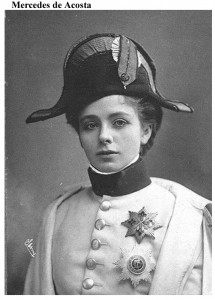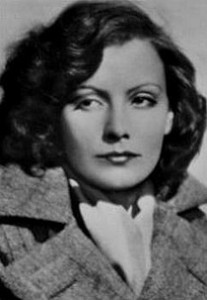 Mercedes de Acosta (March 1, 1893 – May 9, 1968) was an American poet, playwright, and novelist. Four of de Acosta’s plays were produced, and she published a novel and three volumes of poetry. She was professionally unsuccessful but is known for her many lesbian affairs with famous Broadway and Hollywood personalities and numerous friendships with prominent artists of the period.
Mercedes de Acosta (March 1, 1893 – May 9, 1968) was an American poet, playwright, and novelist. Four of de Acosta’s plays were produced, and she published a novel and three volumes of poetry. She was professionally unsuccessful but is known for her many lesbian affairs with famous Broadway and Hollywood personalities and numerous friendships with prominent artists of the period.
She was born in New York City in 1893. Her father, Ricardo de Acosta, was of Cuban and Spanish descent and her mother, Micaela Hernández de Alba y de Alba, was Spanish and reportedly a descendant of the Spanish Dukes of Alba. De Acosta had five siblings: Aida, Ricardo Jr., Angela, Maria, and Rita.
De Acosta attended elementary school at the Covenant of the Blessed Sacrement on West 79th Street in Manhattan where Dorothy Parker was a classmate.
De Acosta married painter Abram Poole (January 1883 Chicago, Illinois – May 24, 1961) in 1920. They divorced in 1935.
De Acosta was involved in numerous lesbian relationships with Broadway’s and Hollywood’s elite and did not attempt to hide her sexuality, which was rare in her generation. In 1916 she began an affair with actress Alla Nazimova and later with dancer Isadora Duncan. Shortly after marrying Abram Poole in 1920, de Acosta became involved in a five-year relationship with actress Eva Le Gallienne. De Acosta wrote two plays for Le Gallienne, Sandro Botticelli and Jehanne de Arc. After the financial failures of both plays they ended their relationship.
Over the next decade she was involved with several famous actresses and dancers including Greta Garbo, Marlene Dietrich, Ona Munson, and Russian ballerina Tamara Platonovna Karsavina. Additional unsubstantiated rumors include Pola Negri, Eleonora Duse, Katharine Cornell, and Alice B. Toklas.
She was described in 1955 by Garbo biographer, John Bainbridge, as “a woman of courtly manners, impeccable decorative taste and great personal elegance… a woman with a passionate and intense devotion to the art of living… and endowed with a high spirit, energy, eclectic curiosity and a varied interest in the arts.”
Relationship with Greta Garbo.
De Acosta’s best-known relationship was with Greta Garbo. When Garbo’s close friend, author Salka Viertel, introduced them in 1931, they quickly became involved. As their relationship developed, it became erratic and volatile with Garbo always in control. The two were very close sporadically and then apart for lengthy periods when Garbo, annoyed by Mercedes’ obsessive behavior, coupled with her own neuroses, ignored her. In any case, they remained friends for thirty years during which time Garbo wrote de Acosta 181 letters, cards, and telegrams. About their friendship, Cecil Beaton, who was close to both women, recorded in his 1958 memoir, “Mercedes is [Garbo’s] very best friend and for 30 years has stood by her, willing to devote her life to her”.
In the early 1930s de Acosta developed an interest in Hinduism and was encouraged to seek out Indian mystic Meher Baba when he arrived in Hollywood.[25] For several years she was captivated by his philosophy and methods and he often gave her advice about ways to address her problems. Later, she studied the philosophy of Hindu sage Ramana Maharishi who introduced her to yoga, meditation, and other spiritual practices she hoped would help ease her suffering. In 1938, she met Hindu dancer Ram Gopal in Hollywood. They immediately established a rapport and became close lifelong friends. Later that year they traveled to India to meet Maharishi.
Robert A. Schanke, de Acosta’s recent biographer, attempts, on the basis of extensive research, to provide an accurate picture of her. She was, Schanke acknowledges, flawed and imperfect, a complex woman who impaired several of her relationships and failed to achieve her professional and romantic aspirations.[39] But he reveals her to have been an exceptionally lively, intelligent, and dynamic person who had many devoted friends. She was, he argues, a brave lesbian of her times and a person of integrity who remained kind and loyal to most everyone with whom she crossed paths. He suggests that the many denigrating portrayals of her may derive from the deep homophobia of her generation.
While the memoir of Mercedes de Acosta was initially unsuccessful, it was rediscovered in the late 1960s and widely read in the underground gay community.
In spite of its inaccuracies, it is now recognized as an important contribution to gay and lesbian history.
Agencies/Various/Wiki/InternetPhotos/www.thecubanhistory.com
The Cuban History, Hollywood.
Arnoldo Varona, Editor.



 MERCEDES DE ACOSTA, poet, Greta Garbo, Marlene Dietrich lover. (Cuban descendant) ** MERCEDES DE ACOSTA, poeta, amante de Isadora Duncan, Alla Nazimova . (Descendiente cubana)
MERCEDES DE ACOSTA, poet, Greta Garbo, Marlene Dietrich lover. (Cuban descendant) ** MERCEDES DE ACOSTA, poeta, amante de Isadora Duncan, Alla Nazimova . (Descendiente cubana)



